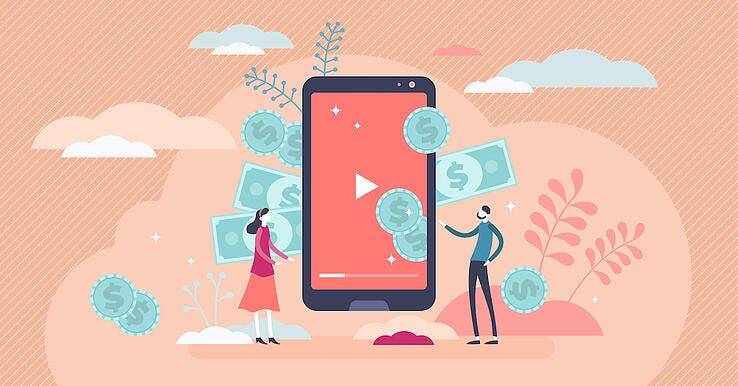Hi Passion Economy fans,
We’ll dive into the business models, derived from fan motivations towards the creator.
New 💰 Resources on the Passion Economy Stack
Means of Creation Interview with Spotify's Head of R&D on their vision for Audio Creators. Gustaf talks about Spotify's goal of 1M creators living off their art via Spotify through enabling multiple business models (ex: subscriptions, freemium, ads, etc). Spotify's new Open Access Platform allows audio creators to connect their existing membership systems (ex: Patreon) to Spotify to enable gated content within the app.
Spotify launched Greenroom (a live audio app to compete with Clubhouse), as well as a creator fund to support live audio streamers.
TikTok launches Shoutouts, a Cameo competitor that allows fans to pay for individual messages from their favorite creators. With Cameo on track to reach over $200M in Sales this year, it's no wonder TikTok is going after this 💸
Shopify has partnered with Netflix to launch an online retail store where viewers can buy merch based on their favorite shows and movies. As Netflix partners with more top creators, this can be a key way for both Netflix & creators to diversify their income. For comparison, Disney makes over $55 Billion a year from merchandise as the top global licensor.
Fan Motivations that Fuel Business Models
All monetization in the passion economy begins with fans. Fans either fund creators directly or incentivize the partners that the creator is working with (ex: advertisers). As a way to understanding the different business models in the passion economy, we'll dive into the different motivations that drive fan behavior.
Inspiration
Fans aspire to become like the creator.
To become a creator, you might want to buy their clothes, follow their productivity hacks, own what they create, understand their behind-the-scenes creation process and more.
What are creators selling: Their lifestyle
Most lucrative business models:
Merch - fans want to buy what a creator buys
NFTs - fans want to own the top things creators create
Exclusive or Behind-The-Scenes content - fans want to see the behind the scenes creation process
Sponsorships and affiliate links - fans can buy the exact same items that a creator uses in their day-to-day life.
Examples of creators: "Lifestyle" creators, Olivia Rodrigo selling her clothing items on Depop
Examples of fans or fan behavior:
Fans asking creators for feedback on their own channels
Fans buying clothes or merch created and worn by the creator
Fans sharing affiliate links of cameras they use to film
Examples of companies that meet this need:
Merch stores like Shopify, Depop, Fourthwall
Affiliate links like Kit (acquired by Patreon)
Education
Fans want to learn something specific from the creator.
Creators have a lot to teach - whether it’s something specific to their niche or how they became a successful creator in the first place. Fans watch videos, read newsletters or buy courses to absorb all the knowledge a creator puts out into the world.
What are creators selling: Their expertise
Most lucrative business models:
Courses
Paid content
Digital products templatizing workflows
Paid access to community of fans that help each other out in their learnings
Paid access to their expertise (ex: 1:1 consulting/tutoring)
Examples of creators:
Airrack or Ali Abdaal creator courses
Lenny's Newsletter Community
Examples of companies that meet this need:
Teachable, Podia, Youtube, TikTok,
Validation
Fans want attention or validation from the creator.
Shoutouts or responses via DMs or comments fuel fan's emotions. Startups & creators capitalize on this interaction through paywalled responses. The closer the interaction with the creator, the more priceless.
What are creators selling: Their attention
Most lucrative business models:
NFTs - fans want the highest tier of attention from the creator
Tips in livestreams - interact live and receive live feedback after you tip
Services or interactions (shoutouts, consulting services, 1:1 educational calls)
Patronage - access to higher tiers means access to more time from the creator
Examples of creators:
OnlyFans creators providing 1:1 attention to top donors
Professional creators providing 1:1 or 1:few consulting or educational content to an audience
Companionship
Community-first fans want to connect with other fans, often times more than connecting with creators.
The creator acts as a facilitator in this scenario, helping bring together fans with shared interests and values that help them connect with one another. Creators might leverage building communities as a strong retention strategy.
What are creators selling: A community
Most lucrative business models:
Communities on Discord (that are either paid or free but increase retention of subscribers)
Gifted Subs: fans gifting paid subscriptions to other members of the community. On Twitch, gifted subs can make as much as 50% of a creators' subscription revenue.
Examples of creators:
Discord communities of Twitch streamers (almost every top Twitch streamer has a Discord community, especially popular for gaming creators).
Examples of fans or fan behavior:
Fans playing games with other fans, hosting watch parties and gifting subscriptions to each other
Entertainment
Fans are entertained by the creator or want the outcome of what the creator creates. Many “lifestyle” creators fall under this bucket for their comedic takes or generally entertaining way of living.
What are creators selling? Art or entertainment factor
Most lucrative business models?
Selling merchandise, artwork, music, etc.
NFTs - so the art is not copied without paying the creator back
Royalties from businesses that use your work
Examples of fans or fan behavior: Fans watching videos to entertain themselves or scrolling through TikTok
Special shoutout to Amy Shen who contributed a large part of these ideas and thoughts.
Have any ideas on what we should cover next? Do you know any exciting business models we didn't cover? Let us know in the comments or by replying to this email.





